Exploring Reuse-Oriented Development in System Analysis and Design
VerifiedAdded on 2020/04/15
|8
|1405
|188
AI Summary
The article delves into the complexity and variability of software processes, comparing three primary models: waterfall, incremental, and reuse-oriented. It highlights the advantages of the reuse-oriented approach in system design, such as cost-effectiveness, error reduction through refined iterations, and enhanced reusability by leveraging existing components. Examples include updates to operating systems like Windows 2007 from its predecessors and iterative game applications for PCs and smartphones. However, challenges arise when full component repertoires are unavailable or improperly delivered, necessitating new designs. The conclusion asserts that reuse-oriented development offers a practical methodology in software engineering, promoting efficiency and continuity.
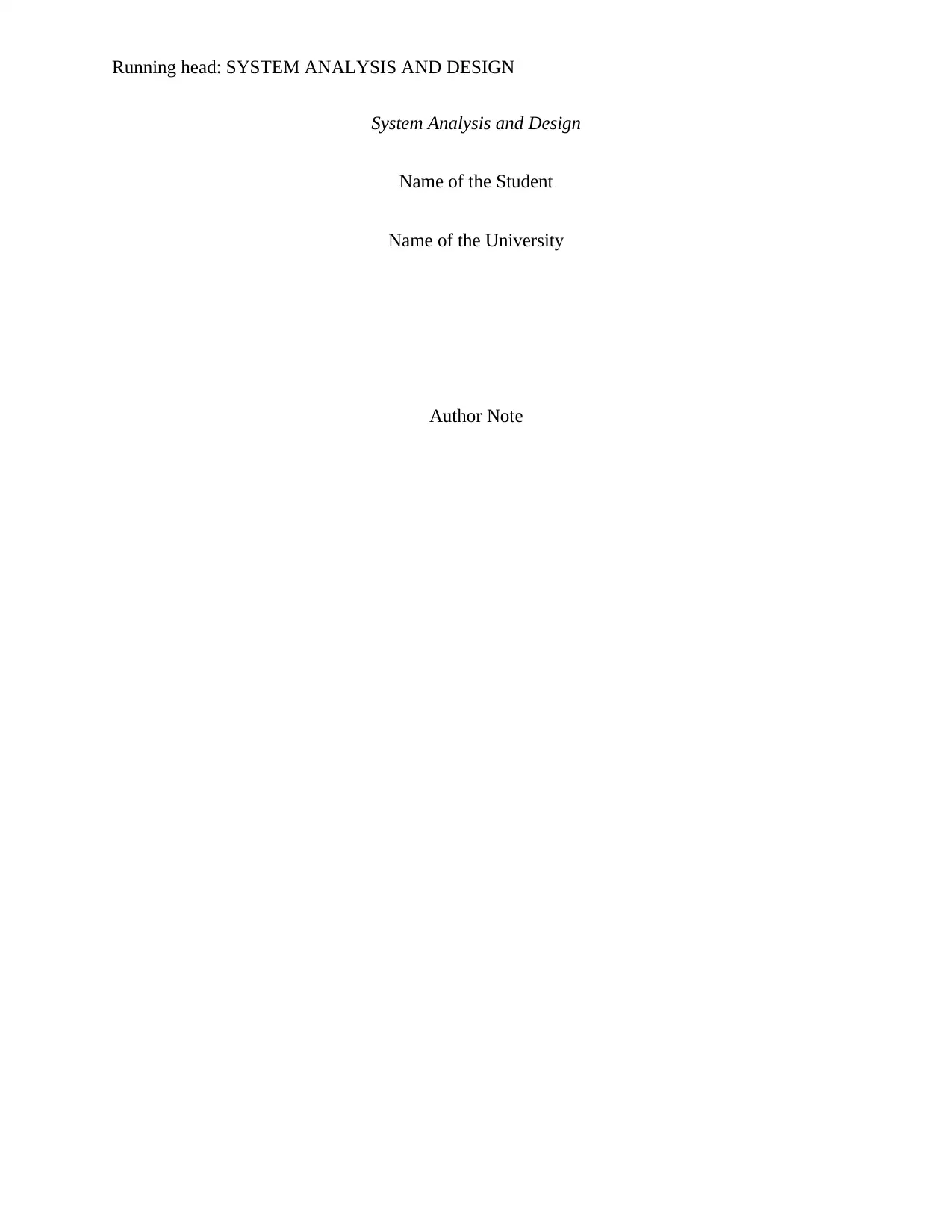
Running head: SYSTEM ANALYSIS AND DESIGN
System Analysis and Design
Name of the Student
Name of the University
Author Note
System Analysis and Design
Name of the Student
Name of the University
Author Note
Paraphrase This Document
Need a fresh take? Get an instant paraphrase of this document with our AI Paraphraser
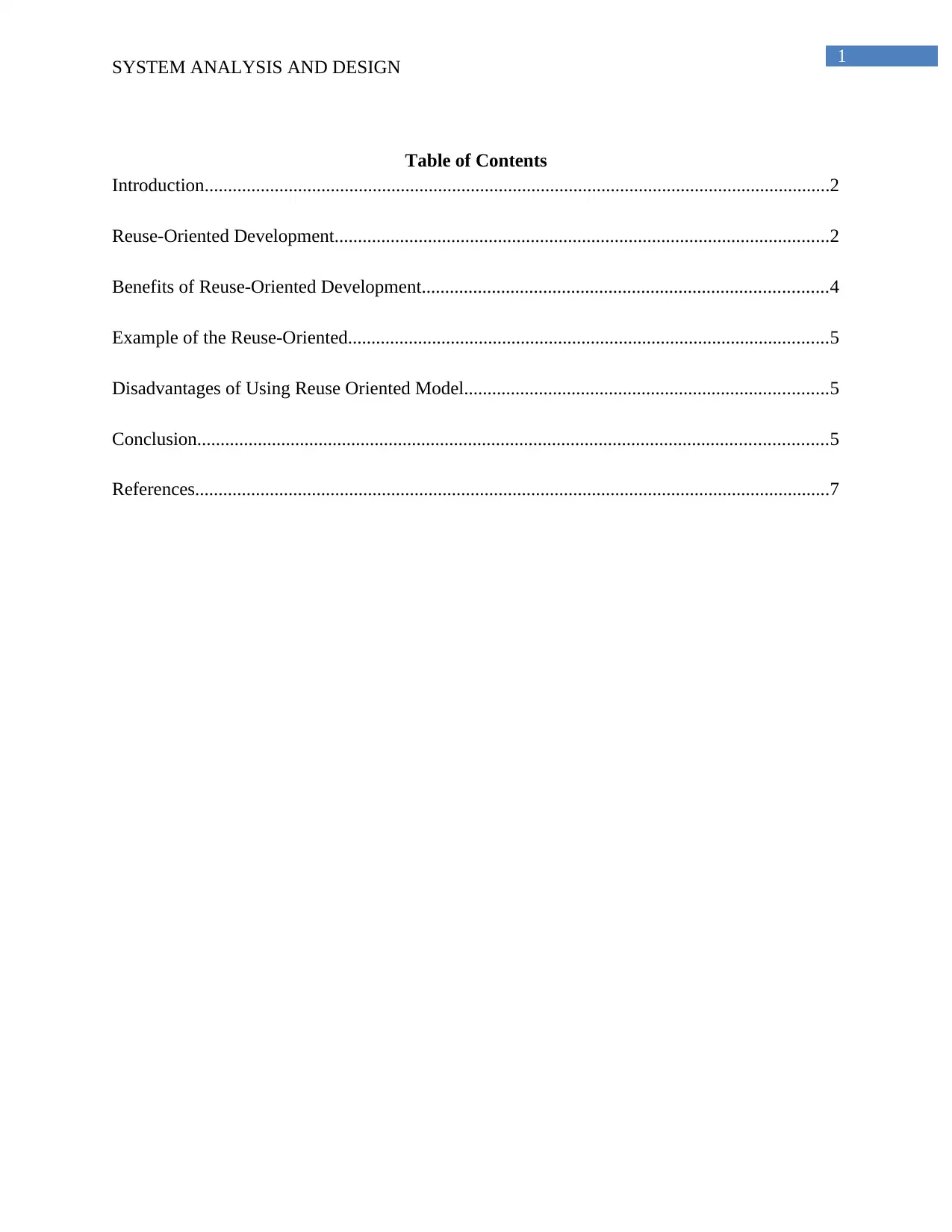
1
SYSTEM ANALYSIS AND DESIGN
Table of Contents
Introduction......................................................................................................................................2
Reuse-Oriented Development..........................................................................................................2
Benefits of Reuse-Oriented Development.......................................................................................4
Example of the Reuse-Oriented.......................................................................................................5
Disadvantages of Using Reuse Oriented Model..............................................................................5
Conclusion.......................................................................................................................................5
References........................................................................................................................................7
SYSTEM ANALYSIS AND DESIGN
Table of Contents
Introduction......................................................................................................................................2
Reuse-Oriented Development..........................................................................................................2
Benefits of Reuse-Oriented Development.......................................................................................4
Example of the Reuse-Oriented.......................................................................................................5
Disadvantages of Using Reuse Oriented Model..............................................................................5
Conclusion.......................................................................................................................................5
References........................................................................................................................................7
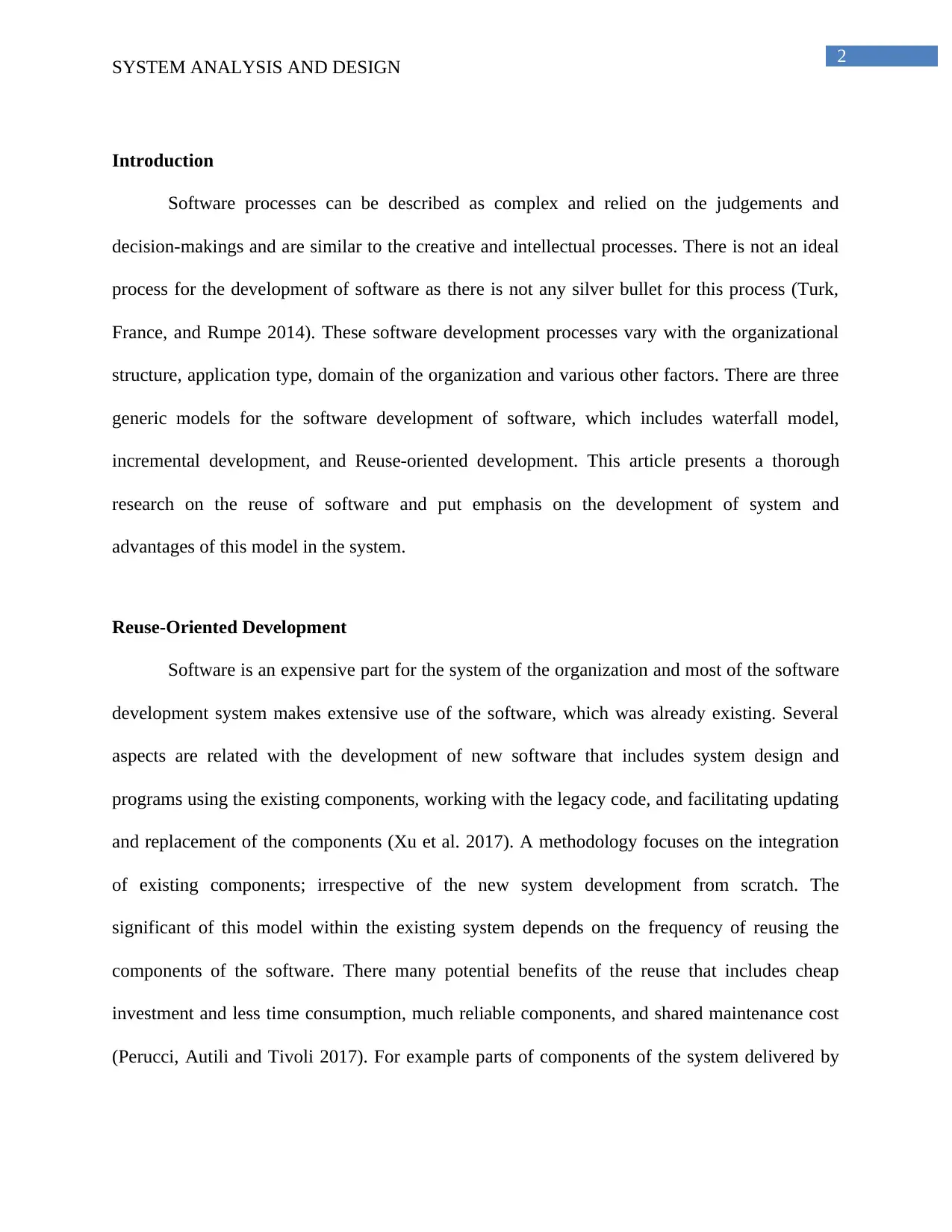
2
SYSTEM ANALYSIS AND DESIGN
Introduction
Software processes can be described as complex and relied on the judgements and
decision-makings and are similar to the creative and intellectual processes. There is not an ideal
process for the development of software as there is not any silver bullet for this process (Turk,
France, and Rumpe 2014). These software development processes vary with the organizational
structure, application type, domain of the organization and various other factors. There are three
generic models for the software development of software, which includes waterfall model,
incremental development, and Reuse-oriented development. This article presents a thorough
research on the reuse of software and put emphasis on the development of system and
advantages of this model in the system.
Reuse-Oriented Development
Software is an expensive part for the system of the organization and most of the software
development system makes extensive use of the software, which was already existing. Several
aspects are related with the development of new software that includes system design and
programs using the existing components, working with the legacy code, and facilitating updating
and replacement of the components (Xu et al. 2017). A methodology focuses on the integration
of existing components; irrespective of the new system development from scratch. The
significant of this model within the existing system depends on the frequency of reusing the
components of the software. There many potential benefits of the reuse that includes cheap
investment and less time consumption, much reliable components, and shared maintenance cost
(Perucci, Autili and Tivoli 2017). For example parts of components of the system delivered by
SYSTEM ANALYSIS AND DESIGN
Introduction
Software processes can be described as complex and relied on the judgements and
decision-makings and are similar to the creative and intellectual processes. There is not an ideal
process for the development of software as there is not any silver bullet for this process (Turk,
France, and Rumpe 2014). These software development processes vary with the organizational
structure, application type, domain of the organization and various other factors. There are three
generic models for the software development of software, which includes waterfall model,
incremental development, and Reuse-oriented development. This article presents a thorough
research on the reuse of software and put emphasis on the development of system and
advantages of this model in the system.
Reuse-Oriented Development
Software is an expensive part for the system of the organization and most of the software
development system makes extensive use of the software, which was already existing. Several
aspects are related with the development of new software that includes system design and
programs using the existing components, working with the legacy code, and facilitating updating
and replacement of the components (Xu et al. 2017). A methodology focuses on the integration
of existing components; irrespective of the new system development from scratch. The
significant of this model within the existing system depends on the frequency of reusing the
components of the software. There many potential benefits of the reuse that includes cheap
investment and less time consumption, much reliable components, and shared maintenance cost
(Perucci, Autili and Tivoli 2017). For example parts of components of the system delivered by
⊘ This is a preview!⊘
Do you want full access?
Subscribe today to unlock all pages.

Trusted by 1+ million students worldwide
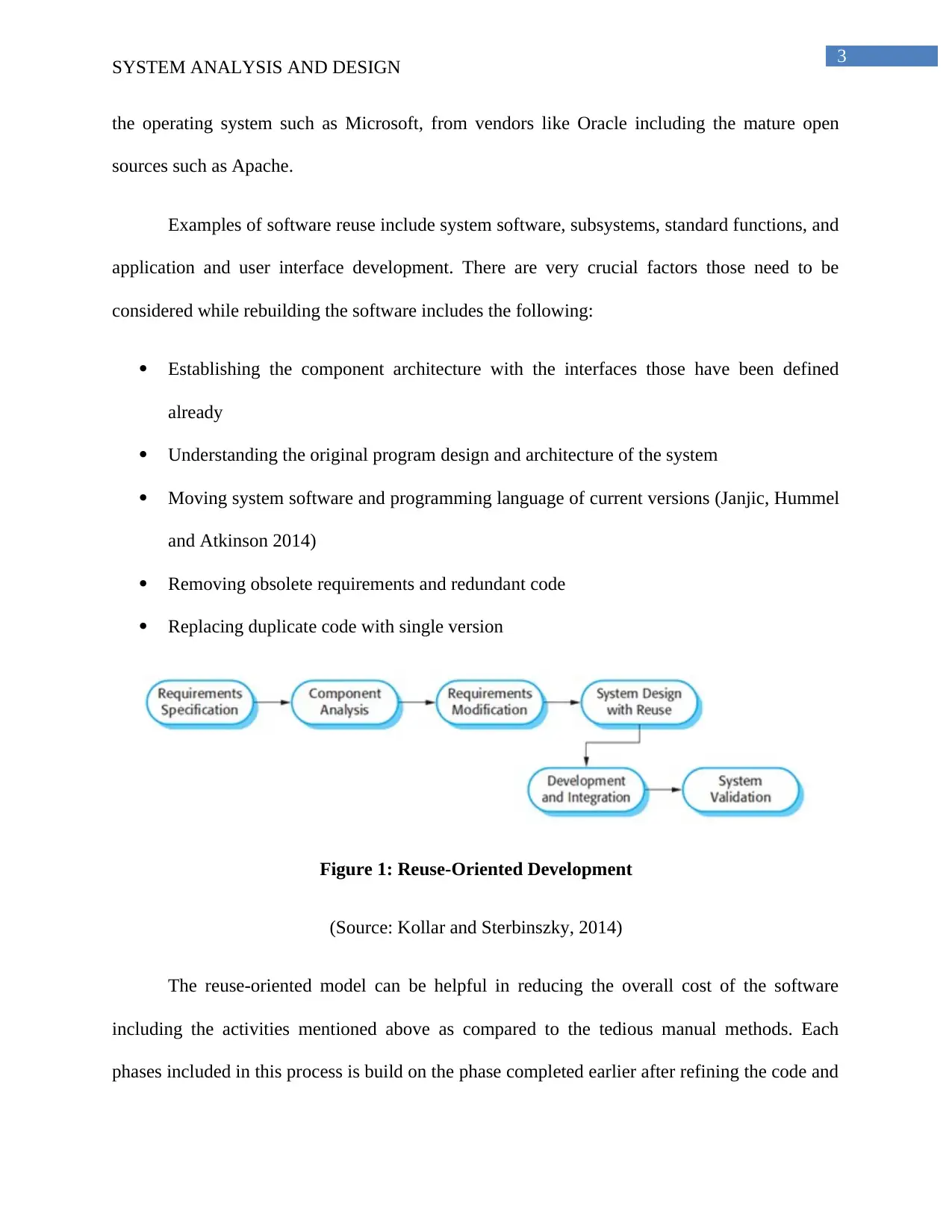
3
SYSTEM ANALYSIS AND DESIGN
the operating system such as Microsoft, from vendors like Oracle including the mature open
sources such as Apache.
Examples of software reuse include system software, subsystems, standard functions, and
application and user interface development. There are very crucial factors those need to be
considered while rebuilding the software includes the following:
Establishing the component architecture with the interfaces those have been defined
already
Understanding the original program design and architecture of the system
Moving system software and programming language of current versions (Janjic, Hummel
and Atkinson 2014)
Removing obsolete requirements and redundant code
Replacing duplicate code with single version
Figure 1: Reuse-Oriented Development
(Source: Kollar and Sterbinszky, 2014)
The reuse-oriented model can be helpful in reducing the overall cost of the software
including the activities mentioned above as compared to the tedious manual methods. Each
phases included in this process is build on the phase completed earlier after refining the code and
SYSTEM ANALYSIS AND DESIGN
the operating system such as Microsoft, from vendors like Oracle including the mature open
sources such as Apache.
Examples of software reuse include system software, subsystems, standard functions, and
application and user interface development. There are very crucial factors those need to be
considered while rebuilding the software includes the following:
Establishing the component architecture with the interfaces those have been defined
already
Understanding the original program design and architecture of the system
Moving system software and programming language of current versions (Janjic, Hummel
and Atkinson 2014)
Removing obsolete requirements and redundant code
Replacing duplicate code with single version
Figure 1: Reuse-Oriented Development
(Source: Kollar and Sterbinszky, 2014)
The reuse-oriented model can be helpful in reducing the overall cost of the software
including the activities mentioned above as compared to the tedious manual methods. Each
phases included in this process is build on the phase completed earlier after refining the code and
Paraphrase This Document
Need a fresh take? Get an instant paraphrase of this document with our AI Paraphraser
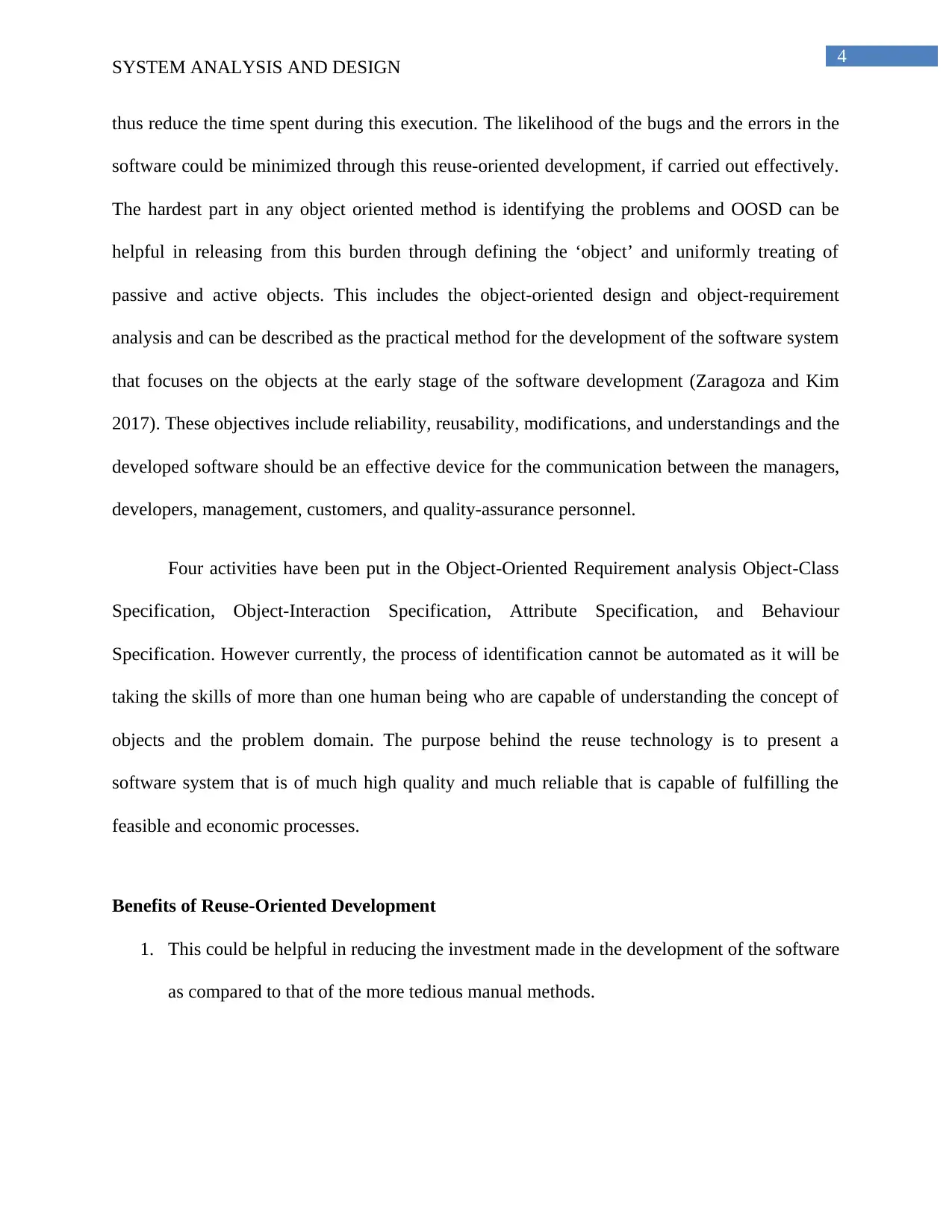
4
SYSTEM ANALYSIS AND DESIGN
thus reduce the time spent during this execution. The likelihood of the bugs and the errors in the
software could be minimized through this reuse-oriented development, if carried out effectively.
The hardest part in any object oriented method is identifying the problems and OOSD can be
helpful in releasing from this burden through defining the ‘object’ and uniformly treating of
passive and active objects. This includes the object-oriented design and object-requirement
analysis and can be described as the practical method for the development of the software system
that focuses on the objects at the early stage of the software development (Zaragoza and Kim
2017). These objectives include reliability, reusability, modifications, and understandings and the
developed software should be an effective device for the communication between the managers,
developers, management, customers, and quality-assurance personnel.
Four activities have been put in the Object-Oriented Requirement analysis Object-Class
Specification, Object-Interaction Specification, Attribute Specification, and Behaviour
Specification. However currently, the process of identification cannot be automated as it will be
taking the skills of more than one human being who are capable of understanding the concept of
objects and the problem domain. The purpose behind the reuse technology is to present a
software system that is of much high quality and much reliable that is capable of fulfilling the
feasible and economic processes.
Benefits of Reuse-Oriented Development
1. This could be helpful in reducing the investment made in the development of the software
as compared to that of the more tedious manual methods.
SYSTEM ANALYSIS AND DESIGN
thus reduce the time spent during this execution. The likelihood of the bugs and the errors in the
software could be minimized through this reuse-oriented development, if carried out effectively.
The hardest part in any object oriented method is identifying the problems and OOSD can be
helpful in releasing from this burden through defining the ‘object’ and uniformly treating of
passive and active objects. This includes the object-oriented design and object-requirement
analysis and can be described as the practical method for the development of the software system
that focuses on the objects at the early stage of the software development (Zaragoza and Kim
2017). These objectives include reliability, reusability, modifications, and understandings and the
developed software should be an effective device for the communication between the managers,
developers, management, customers, and quality-assurance personnel.
Four activities have been put in the Object-Oriented Requirement analysis Object-Class
Specification, Object-Interaction Specification, Attribute Specification, and Behaviour
Specification. However currently, the process of identification cannot be automated as it will be
taking the skills of more than one human being who are capable of understanding the concept of
objects and the problem domain. The purpose behind the reuse technology is to present a
software system that is of much high quality and much reliable that is capable of fulfilling the
feasible and economic processes.
Benefits of Reuse-Oriented Development
1. This could be helpful in reducing the investment made in the development of the software
as compared to that of the more tedious manual methods.
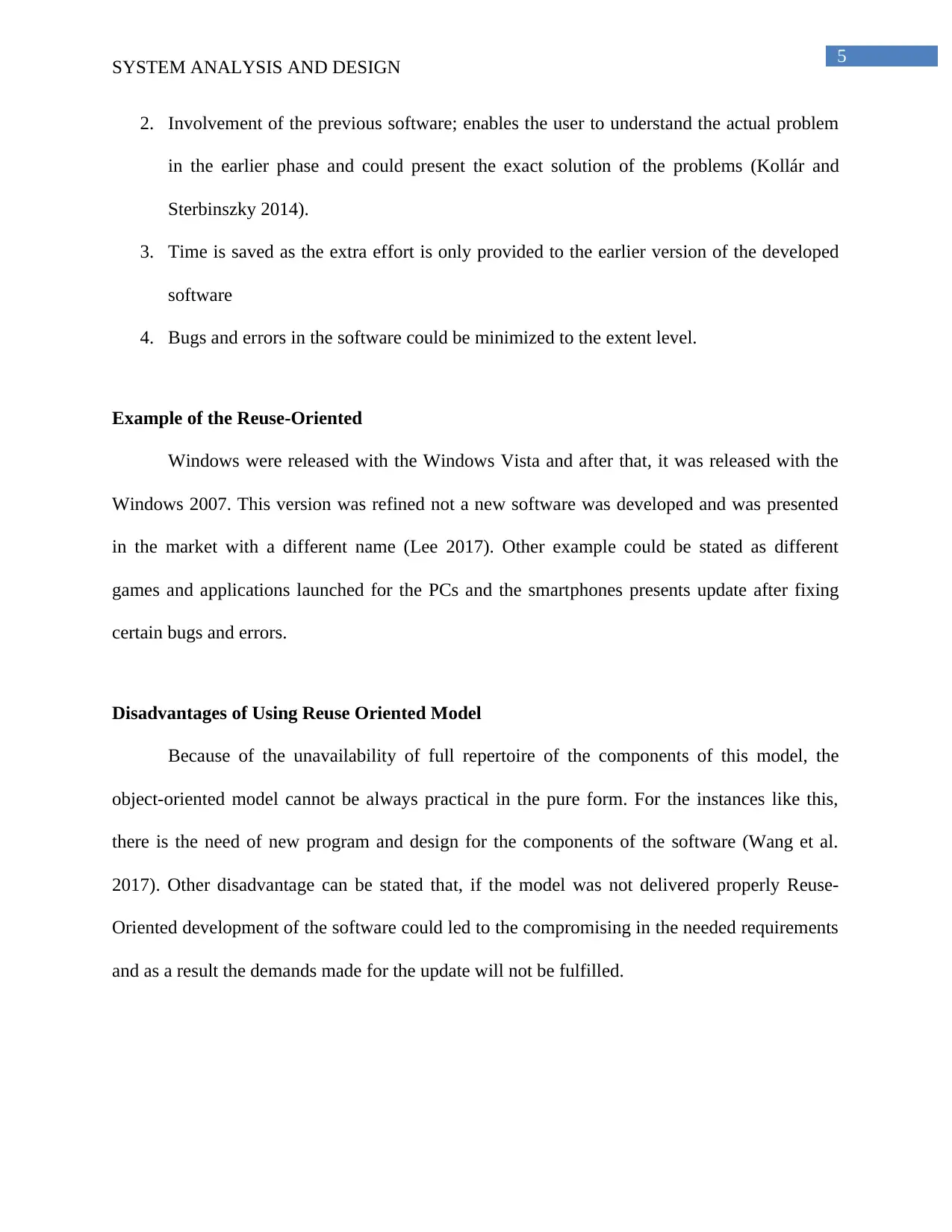
5
SYSTEM ANALYSIS AND DESIGN
2. Involvement of the previous software; enables the user to understand the actual problem
in the earlier phase and could present the exact solution of the problems (Kollár and
Sterbinszky 2014).
3. Time is saved as the extra effort is only provided to the earlier version of the developed
software
4. Bugs and errors in the software could be minimized to the extent level.
Example of the Reuse-Oriented
Windows were released with the Windows Vista and after that, it was released with the
Windows 2007. This version was refined not a new software was developed and was presented
in the market with a different name (Lee 2017). Other example could be stated as different
games and applications launched for the PCs and the smartphones presents update after fixing
certain bugs and errors.
Disadvantages of Using Reuse Oriented Model
Because of the unavailability of full repertoire of the components of this model, the
object-oriented model cannot be always practical in the pure form. For the instances like this,
there is the need of new program and design for the components of the software (Wang et al.
2017). Other disadvantage can be stated that, if the model was not delivered properly Reuse-
Oriented development of the software could led to the compromising in the needed requirements
and as a result the demands made for the update will not be fulfilled.
SYSTEM ANALYSIS AND DESIGN
2. Involvement of the previous software; enables the user to understand the actual problem
in the earlier phase and could present the exact solution of the problems (Kollár and
Sterbinszky 2014).
3. Time is saved as the extra effort is only provided to the earlier version of the developed
software
4. Bugs and errors in the software could be minimized to the extent level.
Example of the Reuse-Oriented
Windows were released with the Windows Vista and after that, it was released with the
Windows 2007. This version was refined not a new software was developed and was presented
in the market with a different name (Lee 2017). Other example could be stated as different
games and applications launched for the PCs and the smartphones presents update after fixing
certain bugs and errors.
Disadvantages of Using Reuse Oriented Model
Because of the unavailability of full repertoire of the components of this model, the
object-oriented model cannot be always practical in the pure form. For the instances like this,
there is the need of new program and design for the components of the software (Wang et al.
2017). Other disadvantage can be stated that, if the model was not delivered properly Reuse-
Oriented development of the software could led to the compromising in the needed requirements
and as a result the demands made for the update will not be fulfilled.
⊘ This is a preview!⊘
Do you want full access?
Subscribe today to unlock all pages.

Trusted by 1+ million students worldwide
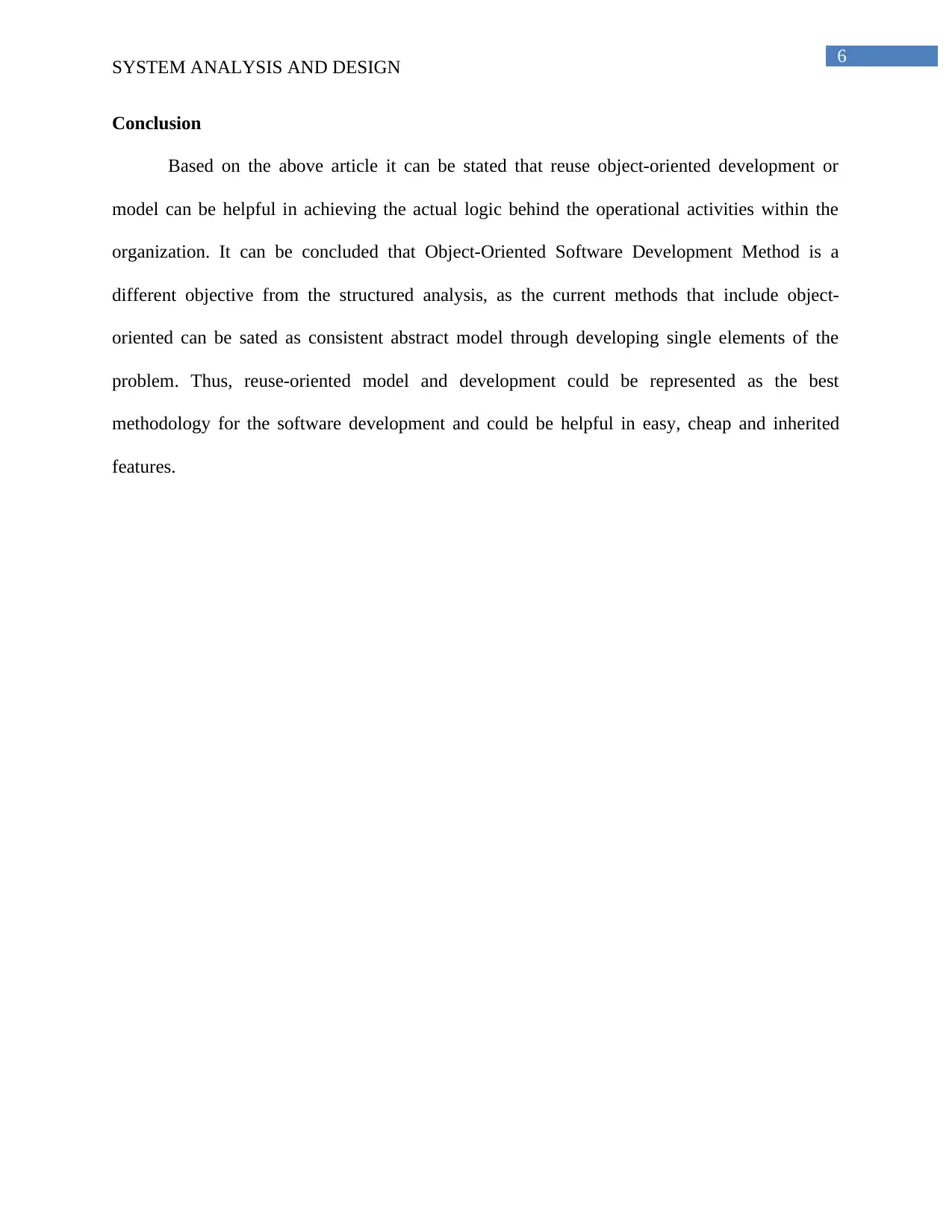
6
SYSTEM ANALYSIS AND DESIGN
Conclusion
Based on the above article it can be stated that reuse object-oriented development or
model can be helpful in achieving the actual logic behind the operational activities within the
organization. It can be concluded that Object-Oriented Software Development Method is a
different objective from the structured analysis, as the current methods that include object-
oriented can be sated as consistent abstract model through developing single elements of the
problem. Thus, reuse-oriented model and development could be represented as the best
methodology for the software development and could be helpful in easy, cheap and inherited
features.
SYSTEM ANALYSIS AND DESIGN
Conclusion
Based on the above article it can be stated that reuse object-oriented development or
model can be helpful in achieving the actual logic behind the operational activities within the
organization. It can be concluded that Object-Oriented Software Development Method is a
different objective from the structured analysis, as the current methods that include object-
oriented can be sated as consistent abstract model through developing single elements of the
problem. Thus, reuse-oriented model and development could be represented as the best
methodology for the software development and could be helpful in easy, cheap and inherited
features.
Paraphrase This Document
Need a fresh take? Get an instant paraphrase of this document with our AI Paraphraser
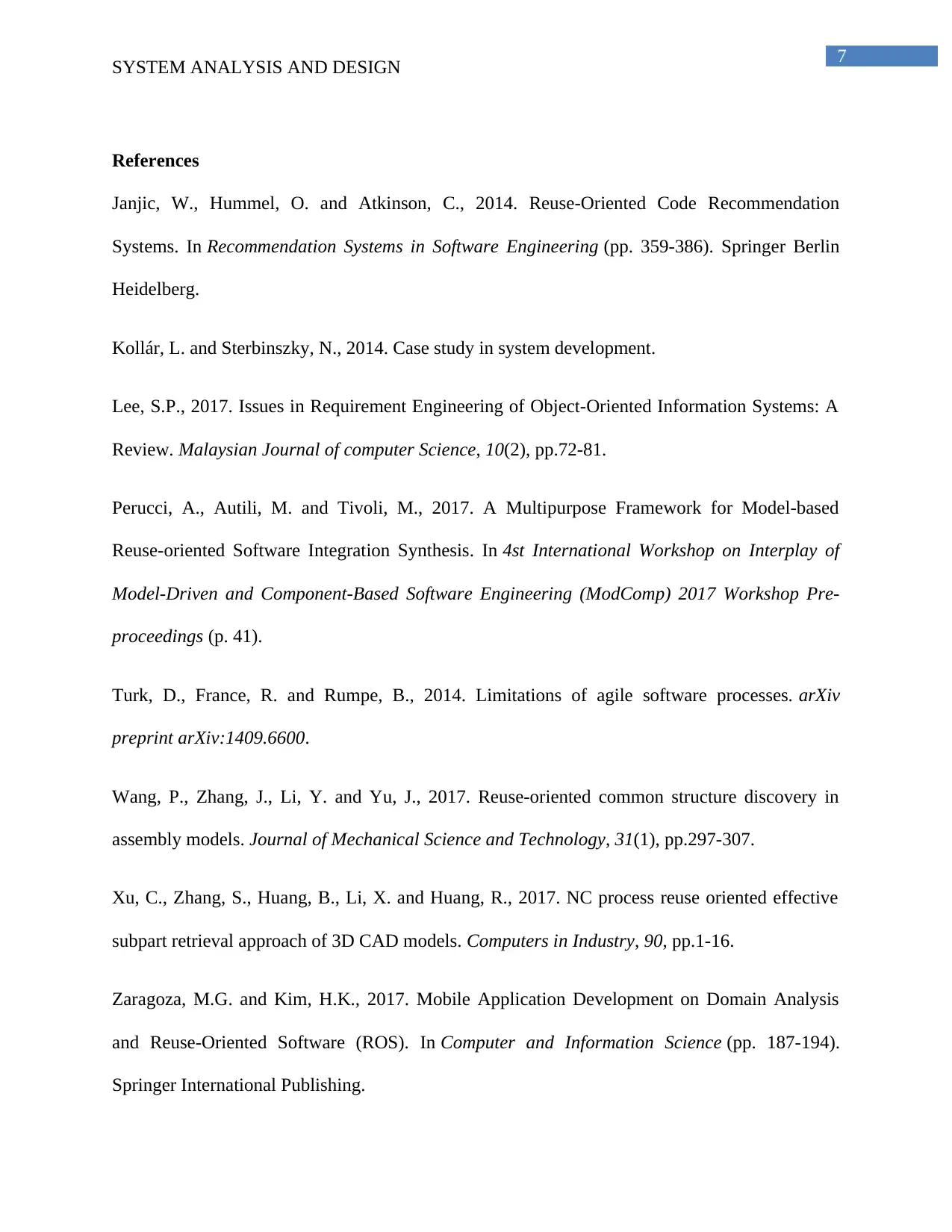
7
SYSTEM ANALYSIS AND DESIGN
References
Janjic, W., Hummel, O. and Atkinson, C., 2014. Reuse-Oriented Code Recommendation
Systems. In Recommendation Systems in Software Engineering (pp. 359-386). Springer Berlin
Heidelberg.
Kollár, L. and Sterbinszky, N., 2014. Case study in system development.
Lee, S.P., 2017. Issues in Requirement Engineering of Object-Oriented Information Systems: A
Review. Malaysian Journal of computer Science, 10(2), pp.72-81.
Perucci, A., Autili, M. and Tivoli, M., 2017. A Multipurpose Framework for Model-based
Reuse-oriented Software Integration Synthesis. In 4st International Workshop on Interplay of
Model-Driven and Component-Based Software Engineering (ModComp) 2017 Workshop Pre-
proceedings (p. 41).
Turk, D., France, R. and Rumpe, B., 2014. Limitations of agile software processes. arXiv
preprint arXiv:1409.6600.
Wang, P., Zhang, J., Li, Y. and Yu, J., 2017. Reuse-oriented common structure discovery in
assembly models. Journal of Mechanical Science and Technology, 31(1), pp.297-307.
Xu, C., Zhang, S., Huang, B., Li, X. and Huang, R., 2017. NC process reuse oriented effective
subpart retrieval approach of 3D CAD models. Computers in Industry, 90, pp.1-16.
Zaragoza, M.G. and Kim, H.K., 2017. Mobile Application Development on Domain Analysis
and Reuse-Oriented Software (ROS). In Computer and Information Science (pp. 187-194).
Springer International Publishing.
SYSTEM ANALYSIS AND DESIGN
References
Janjic, W., Hummel, O. and Atkinson, C., 2014. Reuse-Oriented Code Recommendation
Systems. In Recommendation Systems in Software Engineering (pp. 359-386). Springer Berlin
Heidelberg.
Kollár, L. and Sterbinszky, N., 2014. Case study in system development.
Lee, S.P., 2017. Issues in Requirement Engineering of Object-Oriented Information Systems: A
Review. Malaysian Journal of computer Science, 10(2), pp.72-81.
Perucci, A., Autili, M. and Tivoli, M., 2017. A Multipurpose Framework for Model-based
Reuse-oriented Software Integration Synthesis. In 4st International Workshop on Interplay of
Model-Driven and Component-Based Software Engineering (ModComp) 2017 Workshop Pre-
proceedings (p. 41).
Turk, D., France, R. and Rumpe, B., 2014. Limitations of agile software processes. arXiv
preprint arXiv:1409.6600.
Wang, P., Zhang, J., Li, Y. and Yu, J., 2017. Reuse-oriented common structure discovery in
assembly models. Journal of Mechanical Science and Technology, 31(1), pp.297-307.
Xu, C., Zhang, S., Huang, B., Li, X. and Huang, R., 2017. NC process reuse oriented effective
subpart retrieval approach of 3D CAD models. Computers in Industry, 90, pp.1-16.
Zaragoza, M.G. and Kim, H.K., 2017. Mobile Application Development on Domain Analysis
and Reuse-Oriented Software (ROS). In Computer and Information Science (pp. 187-194).
Springer International Publishing.
1 out of 8
Related Documents
Your All-in-One AI-Powered Toolkit for Academic Success.
+13062052269
info@desklib.com
Available 24*7 on WhatsApp / Email
![[object Object]](/_next/static/media/star-bottom.7253800d.svg)
Unlock your academic potential
Copyright © 2020–2025 A2Z Services. All Rights Reserved. Developed and managed by ZUCOL.





